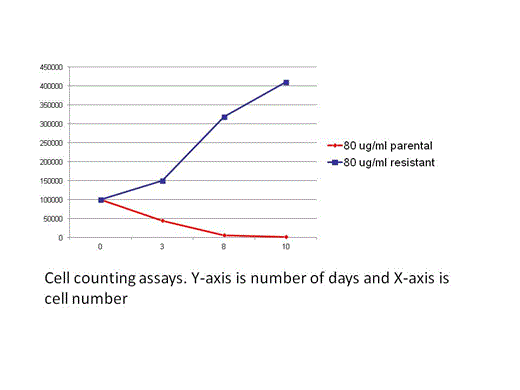Abstract
Brentuximab vedotin (BV) is an antibody-drug conjugate that delivers a potent cytotoxic agent, monomethyl auristatin E (MMAE), specifically to cells expressing surface CD30. In pivotal phase II trials BV demonstrated a complete response rate (CR) of 34% in patients with relapsed/refractory Hodgkin lymphoma (HL) and CR of 50% in patients with relapsed/refractory anaplastic large cell lymphoma (ALCL). However, patients who do not attain CR will eventually develop progressive disease despite active treatment with BV. We aim to select for BV resistant lymphoma cell lines and examine for alterations in surface CD30 expression in cell lines.
In vitro experiments used two HL cell lines (L428, KM-H2) and one ALCL cell line (Karpas 299). The selection of BV resistant cell lines was done in two different approaches (pulsatile and constant exposure). Confirmation of BV resistance was done by MTS assays and cell counting assays. Measurement of surface CD30 was performed by flow cytometry using monoclonal mouse anti-human CD 30, clone Ber-H2.
MTS assay showed the IC50 of parental cell lines to be: L428 (24 ug/ml), KM-H2 (9 ug/ml), and Karpas (16 ng/ml). The cell lines were incubated at supra-IC50 dosage until no proliferation was seen and then rescued with BV free media in the pulsatile approach. Only L428 was able to be rescued and kept in BV free media until consistent proliferation was seen (defined as incremental growth for 3 consecutive weeks). L428 was then incubated again in 50 mg/ml of BV until consistent proliferation was seen. For the constant exposure approach, the cell lines were incubated at sub-IC50 dosages and dosages of BV were adjusted up depending on cell proliferation rates. Only KM-H2 and Karpas 299 showed consistent proliferation in the constant exposure approach. We were able to select for 1 resistant line per cell type. Cell counting assay showed that all three resistant cell lines were able to proliferate in the presence of BV at dosages twice their respective IC50s (Figure 1, only L428 is shown). MTS assays showed that all resistant cell lines had increased IC50s (Table 1). Flow cytometry showed downregulation of surface CD30 expression in Karpas 299 and KM-H2 but not L428 (Table1). For Karpas 299, both the percentage of CD30+ cells and the median CD30 intensity decreased in the resistant line. For KM-H2, only the median CD30 intensity decreased in the resistant line.
Prolonged exposure of HL and ALCL cell lines to BV led to resistant cell lines. When compared to their parental cell lines, two out of three resistant lines showed downregulation in surface CD30 expression.
| . | L428 original . | L428 resistant . | KM-H2 original . | KM-H2 resistant . | Karpas 299 original . | Karpas 299 resistant . |
|---|---|---|---|---|---|---|
| Folds change in Relative IC50 | 1 | 21 X | 1 | 9 X | 1 | 1400 X |
| % CD30+ cells | 99%±0.5% | 98%±1% | 99% ± 0% | 99% ± 0.4% | 97% ± 1% | 55% ± 4% |
| Median CD30 intensity | 111 ± 16 | 111 ± 16 | 126 ± 37 | 61 ± 6 | 248 ± 23 | 53 ± 2 |
| . | L428 original . | L428 resistant . | KM-H2 original . | KM-H2 resistant . | Karpas 299 original . | Karpas 299 resistant . |
|---|---|---|---|---|---|---|
| Folds change in Relative IC50 | 1 | 21 X | 1 | 9 X | 1 | 1400 X |
| % CD30+ cells | 99%±0.5% | 98%±1% | 99% ± 0% | 99% ± 0.4% | 97% ± 1% | 55% ± 4% |
| Median CD30 intensity | 111 ± 16 | 111 ± 16 | 126 ± 37 | 61 ± 6 | 248 ± 23 | 53 ± 2 |
Chen:Seattle Genetics, Inc.: Consultancy, Research Funding, Speakers Bureau, Trave expenses Other.
Author notes
Asterisk with author names denotes non-ASH members.


